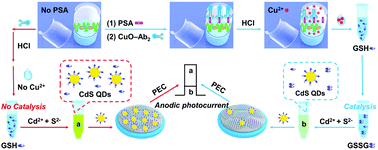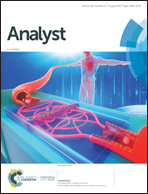Cu2+-Modulated in situ growth of quantum dots for split-type photoelectrochemical immunoassay of prostate-specific antigen†
Abstract
A split-type photoelectrochemical immunosensor was designed for the ultrasensitive monitoring of prostate-specific antigen (PSA) based on a Cu2+-mediated catalytic reaction for inhibiting the in situ generation of CdS quantum dots (QDs) coupled with the enhancement of the CdS/MoS2 heterojunction; it was constructed by the stepwise modification of MoS2 QDs and CdS QDs onto an ITO electrode surface. In the presence of PSA, CuO NP-labeled anti-PSA antibodies were immobilized onto an anti-PSA antibody-modified 96-well plate via a sandwich immunoreaction and dissolution by hydrochloric acid to obtain a large number of Cu2+ ions. As the Cu2+-triggered catalytic oxidization of glutathione occurred, the in situ growth of CdS QDs as a signal indicator was significantly suppressed, resulting in reduction in the photocurrent response. Under optimal conditions, the biosensor exhibited desirable linearity in the range from 0.5 pg mL−1 to 10 ng mL−1, low detection limit of 0.29 pg mL−1, satisfactory selectivity, and good stability. It was applied to PSA detection in human serum, suggesting a great potential for early diagnostics of some cancers.



 Please wait while we load your content...
Please wait while we load your content...